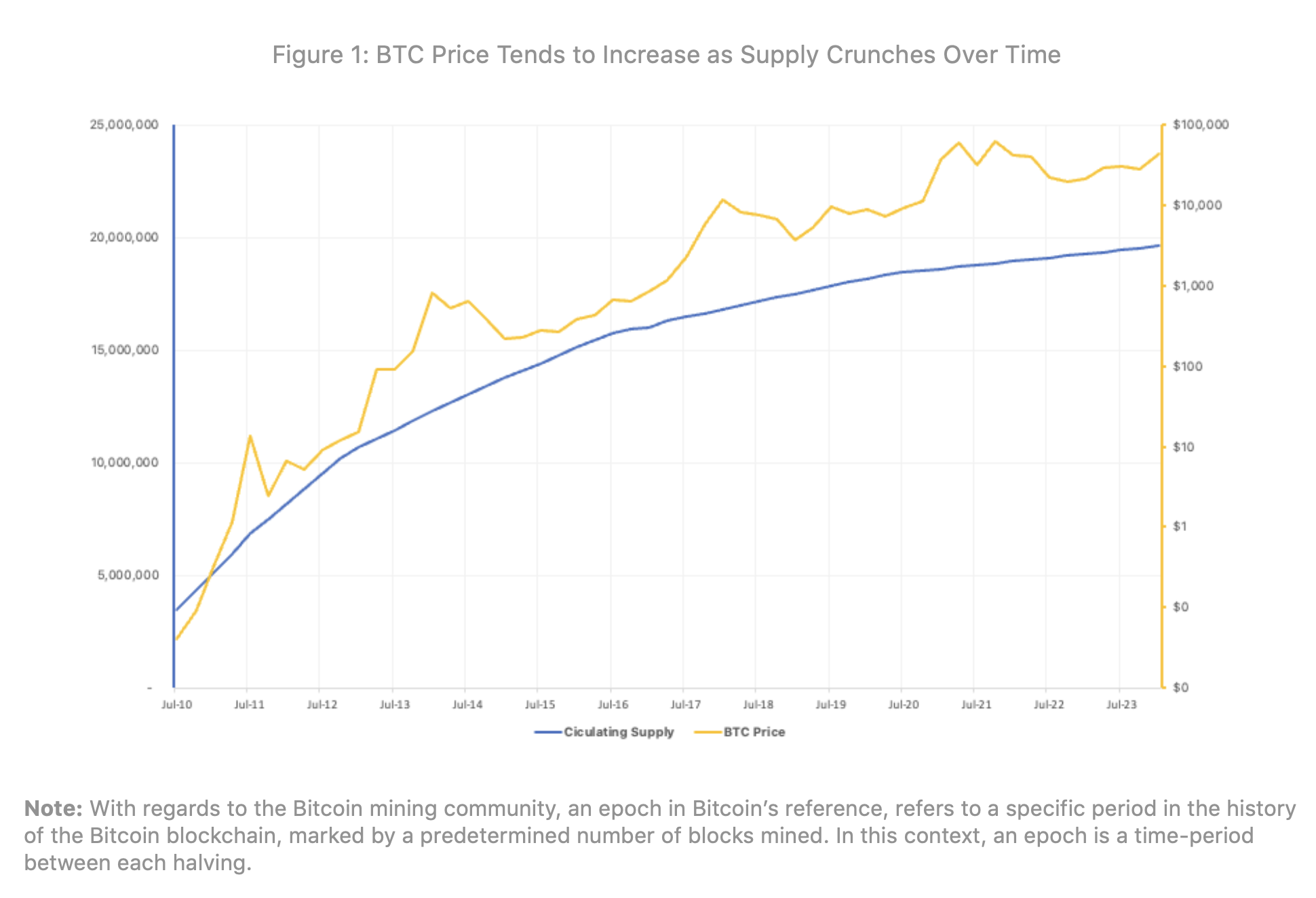By Jean-David Péquignot, Head of Markets, OSL
As the 2024 Bitcoin Halving draws near, it's imperative to reflect on the multitude of significant milestones achieved within this epoch. From prominent corporations integrating BTC into their balance sheets to advancements in Layer-2 solutions, and even entire nations such as El Salvador recognising Bitcoin as legal tender, the landscape of digital assets has experienced remarkable evolution. Perhaps most notably, the recent approval of a Bitcoin Spot ETF by the U.S. SEC underscores a pivotal moment in the mainstream adoption of digital assets. This watershed moment also drove Bitcoin’s price to a new all-time high level. In this short piece, we delve into the historical significance of the halving phenomenon and analyze Bitcoin's performance on either side of these pivotal events.
Defining ‘The Halvening’ and Epochs
A ‘Bitcoin Halving’ is a predetermined event that occurs approximately every four years, in which the reward for mining new Bitcoins is cut in half. This means that the number of new Bitcoins created and earned by miners is reduced by 50%. The purpose of halving is to control Bitcoin's supply and maintain its scarcity, which helps to counteract inflation and maintain the digital assets' value over time.
It's widely agreed upon that Bitcoin halving events tend to have a positive impact on its price, a trend observed throughout history. These events typically foster optimism among crypto investors, resulting in favourable price movements before and afterwards. The upswing in price can be ascribed to various factors. Primarily, the decrease in the supply issuance rate underscores Bitcoin's scarcity, thus amplifying demand and subsequently driving its price higher.

Drawing from historical data, Bitcoin prices have consistently shown a notable surge, averaging over 32% in the two months leading up to a halving event. It's crucial to emphasise that past performance isn't indicative of future results, and the persistence of this pattern isn't guaranteed as the event approaches. Nevertheless, given the heightened anticipation surrounding halving events, prudent investors may consider evaluating the possibility of entering the market sooner, potentially leveraging sustained upward price momentum in the run-up to the halving event. This notion is underscored by Bitcoin recently reaching a new all-time high price of $73,573.
2009 - 2012: Proof of Concept and Early Growth (Epoch 1)
This epoch, spanning from Bitcoin's inception to block 210,000, was characterised by establishing the viability of Bitcoin's underlying blockchain technology. The growth in market capitalization, from $0 at inception to $127 million, signifies the increasing recognition and adoption of Bitcoin as a decentralised digital currency. The significant price rise to $12 showcases early investor interest and speculation in Bitcoin's potential.
2012 - 2016: Volatility and Maturation (Epoch 2)
The period from block 210,000 to 420,000 saw Bitcoin experiencing notable price volatility, with a surge to over $1,000 followed by a significant drop. Despite this volatility, the market cap continued to grow substantially, reaching $10.4 billion by the end of this epoch. The reduction in block rewards to 25 BTC signalled a transition towards a more mature phase, aligning with Bitcoin's increasing adoption and the need to control inflation.
2016 - 2020: Market Maturity and Reduced Supply (Epoch 3)
The third epoch, spanning up to block 630,000, demonstrated further maturation of the Bitcoin market. With the decrease in block rewards to 12.5 BTC, the market cap soared to $160 billion, indicating robust investor confidence and widespread adoption. This epoch's price of $8,761 reflects Bitcoin's established position as a significant digital asset and store of value.

2020 - 2024: Institutional Participation (Epoch 4)
The industry eagerly awaits the conclusion of the fourth epoch, slated to reach its culmination around block 840,000 in mid-April 2024. Presently, Bitcoin (BTC) is on a swift upward trajectory, notably spurred by the recent approval of a Bitcoin Spot ETF granted by the U.S. SEC. As we were writing this, BTC surged past its previous all-time high (ATH) of $69,198, reaching a new peak of $73,573. Although BTC retraced shortly after hitting this new ATH, it is likely to remain well supported over the next few months and despite a decrease in net inflows into U.S. ETFs.
Conclusion
In conclusion, as we stand on the cusp of the 2024 Bitcoin Halving, it's evident that each halving in Bitcoin's history has been marked by remarkable milestones and transformative events. From the pioneering days of its creation to its widespread adoption by corporations and governments alike, Bitcoin has continually demonstrated its resilience and adaptability in the face of evolving market dynamics.
The phenomenon of the halving, characterised by a reduction in the reward for mining new Bitcoin, serves as a cornerstone of the digital asset’s monetary policy, ensuring its scarcity and long-term value proposition. Throughout history, halving events have consistently catalysed optimism within the crypto community, leading to positive price movements and reinforcing Bitcoin's status as a store of value.
As we look ahead to the fourth halving, amidst the excitement around the recent approval of a Bitcoin Spot ETF by the U.S. SEC, it's clear that Bitcoin's journey is far from over. With each halving, Bitcoin continues to solidify its position as a revolutionary financial instrument, reshaping the global economic landscape and captivating the imagination of investors worldwide. Thus, while the future remains uncertain, one thing remains abundantly clear: the epochal journey of Bitcoin is a testament to the enduring power of innovation and decentralisation in the digital age.